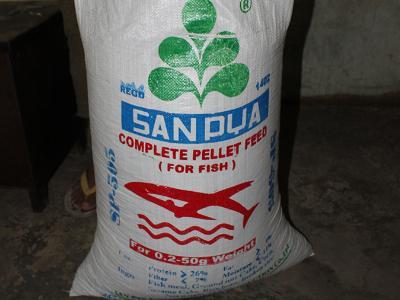F3 blows past funding goals as fishmeal alternatives proliferate

Seventeen companies vying for contest’s still-growing cash prize
Kevin Fitzsimmons, professor at the University of Arizona, says F3 has resulted in "unintended collaborations" between feed manufacturers and feed ingredient suppliers. Courtesy photo.
A competition designed to drive innovation in aquafeeds has blown past its original funding goal and has attracted some of the biggest names in the fish-feed manufacturing world, according to the multi-year event’s organizer.
The F3 Prize, a contest announced last year calling on entrants to create and sell a product utilizing zero marine meals or oils, is now worth more than $200,000, twice the original prize amount, said Kevin Fitzsimmons, professor at the University of Arizona. The school collaborated with the Monterey Bay Aquarium, the New England Aquarium and the organizers of the X-Prize on the competition.
“We’re really pleased to exceed our goal,” Fitzsimmons told the Advocate. “We have a couple of other individuals and foundations who are considering making additional contributions to that prize fund.”
But what Fitzsimmons is most excited about, and is one benefit that he didn’t necessarily anticipate, is the level of collaborations and partnerships that the competition has created. As of last week, there were 17 entrants, he said, including feed manufacturers, ingredient companies and even individual trout and shrimp farms that are specializing in fishmeal-free products.
“What we’re seeing is the ingredient companies are partnering up with the big feed companies. These are unintended collaborations and frankly we’re very pleased about that,” Fitzsimmons said. “It was always part of our intent to try and serve as a go-between for big feed companies and the ingredient suppliers.”
There will still be just one winner, but the winning company — the first to manufacture and sell 100,000 metric tons (MT) of feed by September 2017 — can choose to split the prize money among its collaborators however it so chooses.
They want to use alternative ingredients that will allow them to be competitive with other diets. They want to be competitive, pricewise, and on quality and results.
The organizers of F3 — short for fishmeal free feed — want to make it clear that “fishmeal free” is not intended to paint fishmeal in a negative light. The competition aims to highlight the need for viable fishmeal alternatives and show that the aquafeed industry is keen on managing its dependency on the finite global resource.
One challenge that Fitzsimmons said all manufacturers share is ensuring that any farmed products raised on zero-fishmeal or zero-fish oil diets are just as healthy and nutritious as conventionally fed farmed seafood.
“It’s looking like all the testing and consumer feedback is right on, that the fish are just as high in omega-3s,” he said. “The chefs are all very pleased with the products using these feeds.”
Contest entrants are coming from all corners of the globe, Fitzsimmons said, with companies based in the United States, China, Indonesia, Pakistan, Myanmar and Australia, to name a few. The feeds are designed for many different species, including shrimp, trout, catfish and tilapia. Regardless of where they are based, the contest entrants have several things in common, he added.
“They’re all really looking to be innovative and leading in sustainability,” he said. “They want to use alternative ingredients that will allow them to be competitive with other diets. They want to be competitive, pricewise, and on quality and results. They want the fish or shrimp to have just as good a feed-conversion ratio (FCR), the same high quality, high omega-3 fatty acid content and be just as convenient to use as other products.”
All 17 entrants must now submit a feed sample by the end of August. Additionally, there are four separate sales-submission deadlines throughout 2017 (January, April, July and the final deadline on Sept. 15, 2017) that Fitzsimmons said are structured to help the organizers with due diligence and verification.
“We thought [100,000 MT] was a reasonable amount,” said Fitzsimmons. “If you look at tilapia, with 5 million MT sold around the world; if you figure the FCR at 2:1, that means 10 million MT of feed. So 100,000 MT would only be 1 percent of the world’s tilapia feed. That’s not too difficult to reach. The Chinese companies have bragged that they could do that without much trouble. Others would need to sell virtually everything to get there. It’s wide open, as to who could win this.”
We’ll all have to wait until Dec. 31, 2017, to find out who that will be.
James Wright
- Editorial Manager
- Global Aquaculture Alliance
- Portsmouth, NH, USA
Có thể bạn quan tâm
 Large-scale tilapia project driving aquaculture development in Ivory Coast
Large-scale tilapia project driving aquaculture development in Ivory Coast Has fish farming reached a turning point in sub-Saharan Africa? Large-scale tilapia project driving aquaculture development in Ivory Coast
 Maximizing nutrition for adult marine fish
Maximizing nutrition for adult marine fish Digestible protein-digestible energy ratios key to optimizing feeding efficiency. Maximizing nutrition for adult marine fish
 Fishmeal-free Atlantic salmon feed formulation shows promise
Fishmeal-free Atlantic salmon feed formulation shows promise Joint research between TCFFI, USDA and EWOS uses new diet for post-smolt to food-size fish. Fishmeal-free Atlantic salmon feed formulation shows promise